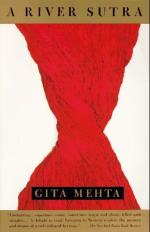|
This section contains 347 words (approx. 1 page at 400 words per page) |

|
A River Sutra Summary & Study Guide Description
A River Sutra Summary & Study Guide includes comprehensive information and analysis to help you understand the book. This study guide contains the following sections:
This detailed literature summary also contains Bibliography and a Free Quiz on A River Sutra by Gita Mehta.
In A River Sutra, Gita Mehta took a new direction in her writing. In her previous works, Karma Cola (1979) and Raj (1989), Mehta had focused on the interactions between India and the Western world. In A River Sutra, Mehta changes focus and explores the diversity of cultures within India. To accomplish this, Mehta presents seemingly unconnected stories in her novel, stories about Hindu and Jain ascetics, courtesans and minstrels, diamond merchants and tea executives, Muslim clerics and music teachers, tribal folk beliefs and the anthropologists who study them. What binds these stories together are two things: the Narmada River and a "sutra." "Sutra," as Mehta explains in the glossary to her novel, means "literally, a thread or string." In the case of her novel, the "sutra" is the theme of love that runs through all the stories, threading them loosely together. The Narmada River stands for another type of "sutra." This river, known as the holiest in India, threads together the diverse people who live on its shores or who come to worship at its waters. The term "sutra" also refers to an Indian literary form, so in the novel, each story is in itself a "sutra" that presents a message. Every time the nameless narrator tries to tease out the meaning of one "sutra," he encounters another pilgrim or lost soul with another story to tell.
Critics have responded positively to A River Sutra. They remark on both the simplicity of the storytelling stylea style as old as Indiaand the complexity of the themes the novel explores. As the reviewer from the Washington Post Book World noted, the stories leave the reader with "the sense that things are richer and more meaningful than they seem, that life is both clear and mysterious, that the beauty and the horror of this world is both irreducible and inexplicable." Critics further praise how Mehta introduces Western readers to a world they have not fathomed. A River Sutra, however, suggests that the "sutra," or the theme of love, running through the stories can connect all people together.
Read more from the Study Guide
|
This section contains 347 words (approx. 1 page at 400 words per page) |

|



